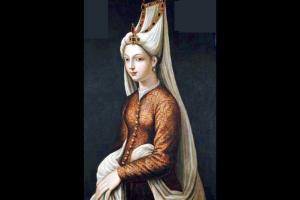Authors of a new illustrated title on Islam explain why the history of the religion is incomplete without its women

Ottoman princess Mihrimah Sultan (dated 1578), Daughter of Sulayman I, had several political connections.
At a time when certain Islamic traditions are mired in controversy, the rich cultural heritage of the religion, which dates back to over 1,400 years, has gone unnoticed. A new book, Islam: An Illustrated Journey, authored by Dr Farhad Daftary and Prof Zulfikar Hirji, attempts to provide a window to understanding the religion better.
Replete with drawings, charts and maps, it introduces us to the various schools of thought, doctrines and interpretations of the religion. "Islam has many faces and voices. It is a testament to the willingness of Muslims to work with local, regional and global cultures to express themselves," says Hirji.

Prof Zulfikar Hirji. Pic/Suresh Karkera
While Hirji is a social historian of Muslim societies and cultures and is currently an associate professor of anthropology at York University in Toronto, his co-author, Daftary, is the co-director of the department of academic research and publications at the Institute of Ismaili Studies in London.
Apart from the descriptions of men who shaped the history of the religion, the book also mentions the contributions of several women who were key patrons and political leaders. "When you read the general histories of Islam, it tends to be written as a series of histories about men as rulers or religious clerics. But there were women, too. We made a very conscious effort to tell those stories and show the ways in which women were absolutely present in all societies and what they meant to the overall history of Islam," Hirji says.
One example here is Khadija, the Prophet's wife; she was one of the first to embrace Islam and played an important role in comforting the Prophet. Citing another example, Hirji mentions the Sultanate of Women during the Ottoman empire. "Some of the men in the Ottoman court were weak rulers and it was the women who carried the dynasty forward by developing international relations, participating in state craft and patronising civic institutions. They were absolutely instrumental in ensuring the longevity of the Ottoman dynasty. Writing a history without women would have been telling half the story," he says.
When asked why misogyny continues in certain Islamic countries, Hirji says this problem is not unique to Islam. He feels the position of women is often based on the reading of texts from a male perspective and also societal norms and customs, which people find difficult to shed.
Hirji says that the Quran, however, addresses Muslim men and women as equal and distinctive entities. "The Quran, in Arabic, says, 'O believing men and believing women'. It actually addresses women directly and specifically in their own right."
When speaking about Islamic architecture, Hirji talks about the incredible diversity of the Muslim experience. For instance, he finds the architecture of the Dome of the Rock in Jerusalem, which was built in the 7th century and has the first monumental Quranic inscription, similar to that of the Church of the Holy Sepulchre - also in Jerusalem - built in AD 326. "The interior themes and motifs in its mosaic tiles are reminiscent of Christian Byzantine mosaic decorations in many buildings of that period. But it also contains Persian, Zoroastrian, Sassanian motifs and is very representative of its age." This was possibly because most artisans during the earliest period of Islam were by and large non-Muslims.
Hirji adds that while in the modern world, the onion-shaped dome and the arch epitomise Islamic architecture, it wasn't true for other periods of time. Here, Hirji refers to the mosque of Xi'an in China, which is a pagoda-styled mosque and bears no resemblance to the global Islamic style. "People find comfort in recognising a form. But the only stipulation here is the direction of the prayer and not the building."
Catch up on all the latest Mumbai news, crime news, current affairs, and also a complete guide on Mumbai from food to things to do and events across the city here. Also download the new mid-day Android and iOS apps to get latest updates
 Subscribe today by clicking the link and stay updated with the latest news!" Click here!
Subscribe today by clicking the link and stay updated with the latest news!" Click here!









